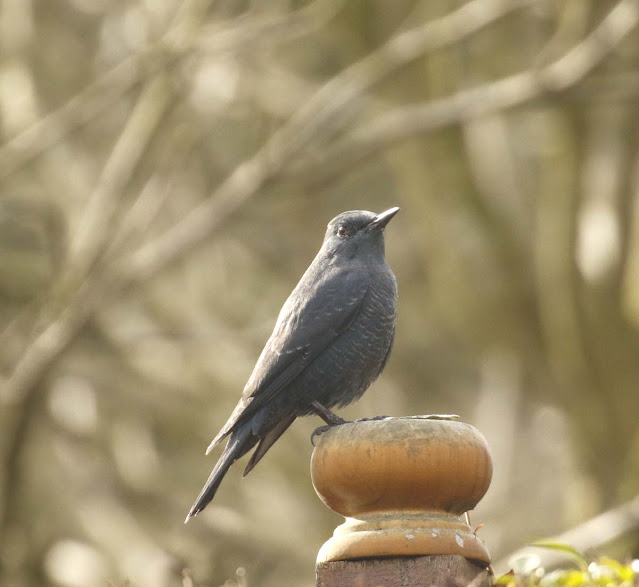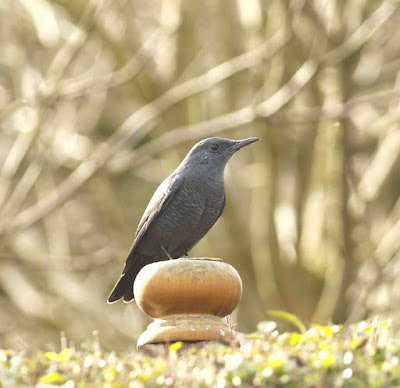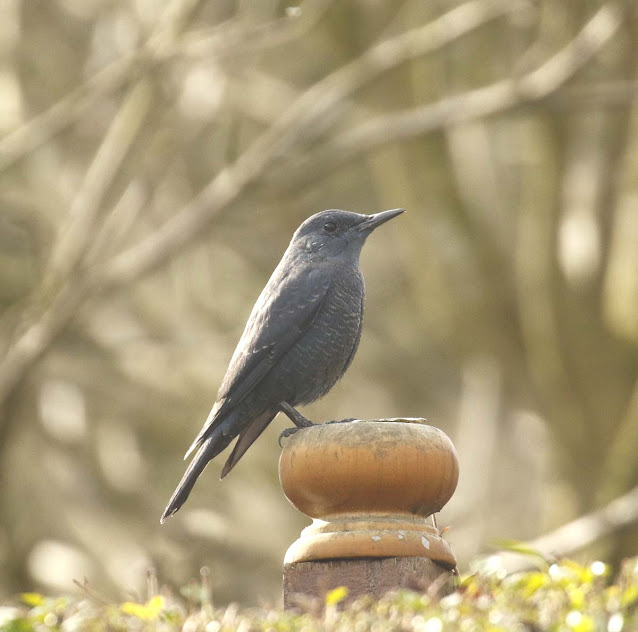The adult male Blue Rock Thrush, first found on or around the 27th December in nearby Stow on the Wold last year, initially created quite a stir and birders from the length and breadth of Britain made the trip to see it but now, some two and a bit months on, just about everyone who wanted to has seen it and the roller coaster of twitching has moved on to other avian matters.
For me, its location in Stow on the Wold is very convenient as I live but five or more minutes drive distant, in the nearby village of Kingham and have been to see the thrush four times now.
Today, after the wind and rain of yesterday, it was calm and sunny so rather than stay behind a computer all day, I drove, in the afternoon, to Stow for another commune with their avian celebrity.
When first found the thrush was frequenting the back garden of No 7 Fisher Close but early in the New Year transferred its allegiance to No 9 Maugersbury Road, which is the next road down in a small and genteel estate of modern housing and it has remained faithful, more or less, to No 9 ever since apart from brief visits back to Fisher Close.
This Blue Rock Thrush is not without controversy and from the very start there are those who have been sceptical or even totally dismissive of the likelihood that it is a truly wild bird. There is absolutely no justification for this attitude but people have strong opinions and are unlikely to be persuaded otherwise. From my point of view I would say, in the bird's favour, that it is wild and not tame, wary enough to survive the attentions of the numerous cats in the area and it is inhabiting built up habitation similar in many respects to where I have encountered them in Greece, Morocco and Cambodia. It has not, as has been suggested escaped from Birdland in nearby Bourton on the Water as they have never kept this species and it is very rarely kept in captivity anywhere in the UK.
So what if it has turned up in the unlikely surrounds of Stow on the Wold. I can remember a Golden winged Warbler, all the way from the USA turning up in a Tesco's car park in Kent many years ago and it too spending most of its time on a housing estate nearby.
For me it is simple. The Blue Rock Thrush is an attractive and rare bird living nearby and it gives me much pleasure to see it and I have accepted that it appears to be existing as a wild bird and no one can prove otherwise.
I confess to feeling more than a little self conscious standing on a pavement closely surrounded by housing and looking up at the roofs of the houses and inevitably their front windows. I tried to be as discrete as possible and was re-assured by the friendly comments from local residents but still it felt uncomfortable to be this close to people's private homes. It is not as if you can look anywhere else, wherever you look you are intruding on a home's privacy but, with the tacit approval of the residents, I stuck it out for an hour, feeling horribly conspicuous, standing out like a sore thumb on the corner of the road waiting for an appearance of the Blue Rock Thrush.
It never happened and in the end I was honestly relieved to leave Maugersbury Road and walk the short distance to Fisher Close and stake out the original garden to see if the thrush was lurking there. I felt more at ease in Fisher Close as there you are in a little cul de sac that does not look directly at any of the houses, and people and cars are not passing you by. Where I stood looks across at the secluded back garden of No 7 although you cannot see into it due to a privet hedge guarding a wood paling fence.You have to wait for the thrush to fly up from feeding in the garden into the couple of trees showing above the fence and privet hedge.
 |
| The garden of No 7 Fisher Close is behind the privet hedge with the two tree tops showing by the shed |
I walked the few metres back to the grassy patch beside No 7's garden and waited for it to appear in one of the trees, which is the usual procedure from past experience. Five minutes later however, it flew up from the garden and perched on the top of the fence enclosing the garden.This was infinitely better and closer than if it had flown into one of the trees. Even better, it then hopped up from the fence top onto a post cap where it showed itself perfectly from all angles
Then with a bob and flick of its wings it descended back into the garden and although I waited another thirty minutes it did not re-appear. I counted myself extremely lucky to have seen it so well, especially as I was on the point of giving up.
I wonder how long it will remain?
The bird was last seen on 27th March in Stow on the Wold and then was found at Beachy Head in East Sussex on 6th April where it spent the day around Belle Toute Lighthouse near to Beachy Head. The next day it was nowhere to be seen and presumably had crossed the Channel in the night and was well on the way back to its normal environment in southern Europe
I wonder how long it will remain?
The bird was last seen on 27th March in Stow on the Wold and then was found at Beachy Head in East Sussex on 6th April where it spent the day around Belle Toute Lighthouse near to Beachy Head. The next day it was nowhere to be seen and presumably had crossed the Channel in the night and was well on the way back to its normal environment in southern Europe
















No comments:
Post a Comment